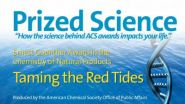Beauty from the bottom up
New study shows flamingos add natural color to their feathers to look good and attract mates
2010-10-26
(Press-News.org) Flamingos apply natural make-up to their feathers to stand out and attract mates, according to a new study by Juan Amat, from the Estación Biológica de Doňana in Seville, Spain, and colleagues. Their research is the first to demonstrate that birds transfer the color pigments (carotenoids) from the secretions of their uropygial gland for cosmetic reasons. The uropygial or preen gland is found in the majority of birds and is situated near the base of the tail. The study is published online in Behavioral Ecology and Sociobiology, a Springer journal.
There is evidence that the color of feathers may change due to abrasion, photochemical change and staining, either accidental or deliberate. Some bird species modify the color of their feathers by deliberately applying substances that are either produced by the birds themselves or from external sources. Among the substances produced by birds are the secretions of the uropygial gland, which may be pigmented orange, red or yellow.
Amat and team studied seasonal variations in plumage color in relation to courtship activity of the greater flamingo Phoenicopterus roseus in Spain. They then looked for the pigments that may tinge the plumage both in the secretions of the uropygial gland and on the surface of feathers. They also observed whether the birds displayed a specific behavior to acquire and maintain the coloration of their feathers. Lastly, they compared the timing of cosmetic coloration with annual reproductive patterns - egg-laying specifically.
They found that the plumage of flamingos was more colorful during periods in which the birds were displaying in groups and faded during the rest of the year. This fading occurred shortly after the birds started to breed. They also found evidence that the birds transferred carotenoids from their uropygial gland to their feathers by rubbing their head on their neck, breast and back feathers. Because rubbing behavior was much more frequent during periods when the birds were displaying in groups and the color of the feathers faded after egg hatching, the authors believe that the primary function of cosmetic coloration in flamingos may be related to mate choice.
They conclude: "Our findings in flamingos have important implications for the theories of sexual selection and signaling, highlighting the key role of the manipulation of plumage color by the birds themselves to improve signal efficacy."
INFORMATION:
Reference
1. Amat JA et al (2010). Greater flamingos Phoenicopterus roseus use uropygial secretions as make-up. Behavioral Ecology and Sociobiology; DOI: 10.1007/s00265-010-1068-z
The full-text article is available to journalists on request.
END
ELSE PRESS RELEASES FROM THIS DATE:
2010-10-26
AUGUSTA, Ga. - A daily dose of whole body vibration may help reduce the usual bone density loss that occurs with age, Medical College of Georgia researchers report.
Twelve weeks of daily, 30-minute sessions in 18-month old male mice – which equate to 55- to 65-year-old humans – appear to forestall the expected annual loss that can result in fractures, disability and death. Dr. Karl H. Wenger, biomedical engineer in the MCG Schools of Graduate Studies and Medicine, reported the findings with his colleagues in the journal Bone.
Researchers found vibration improved density ...
2010-10-26
A popular cancer drug could be produced cheaply and sustainably using stem cells derived from trees, a study suggests.
Researchers have isolated and grown stem cells from a yew tree whose bark is a natural source of the anticancer compound paclitaxel. The development could enable the compound to be produced on a commercial scale at low cost, with no harmful by-products.
Scientists and engineers behind the development say the drug treatment – currently used on lung, ovarian, breast, head and neck cancer – could become cheaper and more widely available.
The study was ...
2010-10-26
Patients with cancer found at the end of the large intestine called the rectum who receive one week of radiation therapy before surgery have a 50 percent reduction in chance that their cancer will return after 10 years, according to a large, randomized study presented at the plenary session, November 1, 2010, at the 52nd Annual Meeting of the American Society for Radiation Oncology (ASTRO).
"We believe that this short course of radiation will open a new window of opportunities in the treatment of rectal cancer," Corrie Marijnen M.D., lead author of the study and a radiation ...
2010-10-26
Men with prostate cancer who take anticoagulants like aspirin in addition to radiation therapy or surgery may be able to cut their risk of dying of the disease by more than half, according to a large study presented on November 3, 2010, at the 52nd Annual Meeting of the American Society for Radiation Oncology (ASTRO) in San Diego. The study involved more than 5,000 men with localized cancer whose disease had not spread beyond the prostate gland.
"Evidence has shown that anticoagulants may interfere with cancer growth and spread," Kevin Choe, M.D., Ph.D., lead author of ...
2010-10-26
Men treated for prostate cancer who were diagnosed after the start of routine screening had a significantly reduced risk of the disease spreading to other parts of the body (metastases) within 10 years of treatment, compared to men who were treated prior to the use of routine screening, according to the first study-of-its-kind presented November 1, 2010, at the 52nd Annual Meeting of the American Society for Radiation Oncology (ASTRO).
In 1993, routine prostate cancer screening became widely implemented through the use of a prostate specific antigen (PSA) test that was ...
2010-10-26
Prostate cancer patients who are treated with a combination of hormone therapy and radiation have a substantially improved chance of survival compared to patients who do not receive radiation, according to interim results of the largest randomized study of its kind presented at the plenary session, November 1, 2010, at the 52nd Annual Meeting of the American Society for Radiation Oncology (ASTRO).
From 1995 to 2005, 1,205 men with high-risk prostate cancer in the United States, the United Kingdom and Canada were randomly selected to receive hormone therapy alone or a ...
2010-10-26
WASHINGTON, Oct. 25, 2010 — Green gasoline is plants in your tank, motor vehicle fuel made from corn, cornstalks, sugarcane, and other crops. It also is gasoline made with recipes that reduce the need for harsh, potentially toxic ingredients like hydrofluoric acid or sulfuric acid that are used at about 210 oil refineries worldwide. Now scientists have found an answer to a half-century quest for a way to make gasoline in exactly that kind of greener, more environmentally-friendly way.
That advance highlights the second episode of a new video series, Prized Science: ...
2010-10-26
Men with prostate cancer treated with a specialized type of radiation called intensity modulated radiation therapy (IMRT) have fewer gastrointestinal complications compared to patients treated with conventional three-dimensional conformal radiotherapy (3D-CRT), according to a study presented November 1, 2010, at the 52nd Annual Meeting of the American Society for Radiation Oncology (ASTRO).
"With survivors living many years after treatment, it is very important to minimize gastrointestinal and urinary side effects to allow patients to live a full life after treatment," ...
2010-10-26
A lower dose of radiation used to reduce side effects is not as effective as the regular dose when given with the standard chemotherapy in the treatment of Hodgkin's lymphoma patients with early, intermediate-stage disease, according to a first-of-its-kind randomized study presented at the plenary session, November 1, 2010, at the 52nd Annual Meeting of the American Society for Radiation Oncology (ASTRO).
In addition, the trial showed that a more intensive chemotherapy (BEACOPP) is not more effective than the standard chemotherapy treatment (ABVD) for these patients.
"This ...
2010-10-26
BOSTON (October 25, 2010) — Researchers from Tufts University pooled data from five previous epidemiological studies to investigate the prevalence of asthma in children in the Boston neighborhoods of Chinatown and Dorchester. Among children born in the United States, low socioeconomic status (SES) and exposure to pests (mice and cockroaches) were both associated with having asthma. Neither association was present in children born outside of the United States. The study was published online in advance of print in the Journal of Immigrant and Minority Health.
"In earlier ...
LAST 30 PRESS RELEASES:
[Press-News.org] Beauty from the bottom up
New study shows flamingos add natural color to their feathers to look good and attract mates

